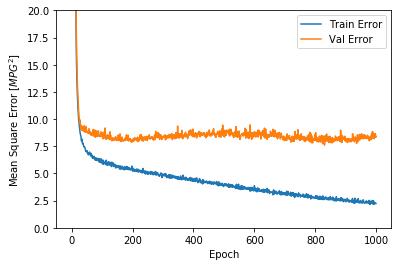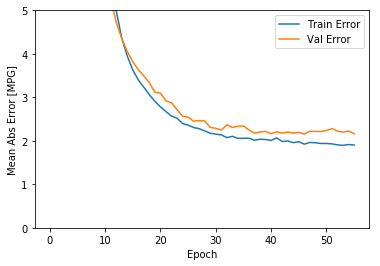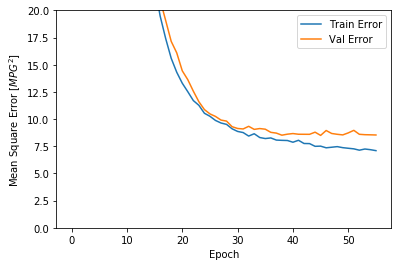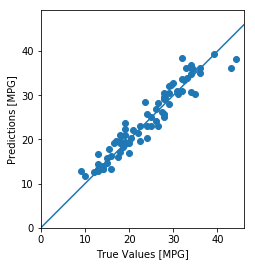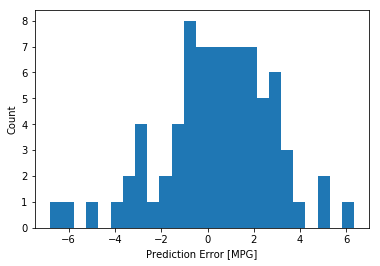Note: 我们的 TensorFlow 社区翻译了这些文档。因为社区翻译是尽力而为, 所以无法保证它们是最准确的,并且反映了最新的 官方英文文档。如果您有改进此翻译的建议, 请提交 pull request 到 tensorflow/docs GitHub 仓库。要志愿地撰写或者审核译文,请加入 [email protected] Google Group。
在 回归 (regression) 问题中,我们的目的是预测出如价格或概率这样连续值的输出。相对于分类(classification) 问题,分类(classification) 的目的是从一系列的分类出选择出一个分类 (如,给出一张包含苹果或橘子的图片,识别出图片中是哪种水果)。
本 notebook 使用经典的 Auto MPG 数据集,构建了一个用来预测70年代末到80年代初汽车燃油效率的模型。为了做到这一点,我们将为该模型提供许多那个时期的汽车描述。这个描述包含:气缸数,排量,马力以及重量。
本示例使用 tf.keras API,相关细节请参阅 本指南。
# 使用 seaborn 绘制矩阵图 (pairplot)
!pip install seabornRequirement already satisfied: seaborn in /usr/local/lib/python3.6/dist-packages (0.9.0)
Requirement already satisfied: scipy>=0.14.0 in /usr/local/lib/python3.6/dist-packages (from seaborn) (1.3.1)
Requirement already satisfied: numpy>=1.9.3 in /usr/local/lib/python3.6/dist-packages (from seaborn) (1.16.5)
Requirement already satisfied: matplotlib>=1.4.3 in /usr/local/lib/python3.6/dist-packages (from seaborn) (3.0.3)
Requirement already satisfied: pandas>=0.15.2 in /usr/local/lib/python3.6/dist-packages (from seaborn) (0.24.2)
Requirement already satisfied: pyparsing!=2.0.4,!=2.1.2,!=2.1.6,>=2.0.1 in /usr/local/lib/python3.6/dist-packages (from matplotlib>=1.4.3->seaborn) (2.4.2)
Requirement already satisfied: kiwisolver>=1.0.1 in /usr/local/lib/python3.6/dist-packages (from matplotlib>=1.4.3->seaborn) (1.1.0)
Requirement already satisfied: cycler>=0.10 in /usr/local/lib/python3.6/dist-packages (from matplotlib>=1.4.3->seaborn) (0.10.0)
Requirement already satisfied: python-dateutil>=2.1 in /usr/local/lib/python3.6/dist-packages (from matplotlib>=1.4.3->seaborn) (2.5.3)
Requirement already satisfied: pytz>=2011k in /usr/local/lib/python3.6/dist-packages (from pandas>=0.15.2->seaborn) (2018.9)
Requirement already satisfied: setuptools in /usr/local/lib/python3.6/dist-packages (from kiwisolver>=1.0.1->matplotlib>=1.4.3->seaborn) (41.4.0)
Requirement already satisfied: six in /usr/local/lib/python3.6/dist-packages (from cycler>=0.10->matplotlib>=1.4.3->seaborn) (1.12.0)
from __future__ import absolute_import, division, print_function, unicode_literals
import pathlib
import matplotlib.pyplot as plt
import pandas as pd
import seaborn as sns
try:
# %tensorflow_version only exists in Colab.
%tensorflow_version 2.x
except Exception:
pass
import tensorflow as tf
from tensorflow import keras
from tensorflow.keras import layers
print(tf.__version__)TensorFlow 2.x selected.
2.0.0
该数据集可以从 UCI机器学习库 中获取.
首先下载数据集。
dataset_path = keras.utils.get_file("auto-mpg.data", "http://archive.ics.uci.edu/ml/machine-learning-databases/auto-mpg/auto-mpg.data")
dataset_pathDownloading data from http://archive.ics.uci.edu/ml/machine-learning-databases/auto-mpg/auto-mpg.data
32768/30286 [================================] - 0s 4us/step
'/root/.keras/datasets/auto-mpg.data'
使用 pandas 导入数据集。
column_names = ['MPG','Cylinders','Displacement','Horsepower','Weight',
'Acceleration', 'Model Year', 'Origin']
raw_dataset = pd.read_csv(dataset_path, names=column_names,
na_values = "?", comment='\t',
sep=" ", skipinitialspace=True)
dataset = raw_dataset.copy()
dataset.tail()| MPG | Cylinders | Displacement | Horsepower | Weight | Acceleration | Model Year | Origin | |
|---|---|---|---|---|---|---|---|---|
| 393 | 27.0 | 4 | 140.0 | 86.0 | 2790.0 | 15.6 | 82 | 1 |
| 394 | 44.0 | 4 | 97.0 | 52.0 | 2130.0 | 24.6 | 82 | 2 |
| 395 | 32.0 | 4 | 135.0 | 84.0 | 2295.0 | 11.6 | 82 | 1 |
| 396 | 28.0 | 4 | 120.0 | 79.0 | 2625.0 | 18.6 | 82 | 1 |
| 397 | 31.0 | 4 | 119.0 | 82.0 | 2720.0 | 19.4 | 82 | 1 |
数据集中包括一些未知值。
dataset.isna().sum()MPG 0
Cylinders 0
Displacement 0
Horsepower 6
Weight 0
Acceleration 0
Model Year 0
Origin 0
dtype: int64
为了保证这个初始示例的简单性,删除这些行。
dataset = dataset.dropna()"Origin" 列实际上代表分类,而不仅仅是一个数字。所以把它转换为独热码 (one-hot):
origin = dataset.pop('Origin')dataset['USA'] = (origin == 1)*1.0
dataset['Europe'] = (origin == 2)*1.0
dataset['Japan'] = (origin == 3)*1.0
dataset.tail()| MPG | Cylinders | Displacement | Horsepower | Weight | Acceleration | Model Year | USA | Europe | Japan | |
|---|---|---|---|---|---|---|---|---|---|---|
| 393 | 27.0 | 4 | 140.0 | 86.0 | 2790.0 | 15.6 | 82 | 1.0 | 0.0 | 0.0 |
| 394 | 44.0 | 4 | 97.0 | 52.0 | 2130.0 | 24.6 | 82 | 0.0 | 1.0 | 0.0 |
| 395 | 32.0 | 4 | 135.0 | 84.0 | 2295.0 | 11.6 | 82 | 1.0 | 0.0 | 0.0 |
| 396 | 28.0 | 4 | 120.0 | 79.0 | 2625.0 | 18.6 | 82 | 1.0 | 0.0 | 0.0 |
| 397 | 31.0 | 4 | 119.0 | 82.0 | 2720.0 | 19.4 | 82 | 1.0 | 0.0 | 0.0 |
现在需要将数据集拆分为一个训练数据集和一个测试数据集。
我们最后将使用测试数据集对模型进行评估。
train_dataset = dataset.sample(frac=0.8,random_state=0)
test_dataset = dataset.drop(train_dataset.index)快速查看训练集中几对列的联合分布。
sns.pairplot(train_dataset[["MPG", "Cylinders", "Displacement", "Weight"]], diag_kind="kde")<seaborn.axisgrid.PairGrid at 0x7f3d9243a6a0>
也可以查看总体的数据统计:
train_stats = train_dataset.describe()
train_stats.pop("MPG")
train_stats = train_stats.transpose()
train_stats.dataframe tbody tr th {
vertical-align: top;
}
.dataframe thead th {
text-align: right;
}
| count | mean | std | min | 25% | 50% | 75% | max | |
|---|---|---|---|---|---|---|---|---|
| Cylinders | 314.0 | 5.477707 | 1.699788 | 3.0 | 4.00 | 4.0 | 8.00 | 8.0 |
| Displacement | 314.0 | 195.318471 | 104.331589 | 68.0 | 105.50 | 151.0 | 265.75 | 455.0 |
| Horsepower | 314.0 | 104.869427 | 38.096214 | 46.0 | 76.25 | 94.5 | 128.00 | 225.0 |
| Weight | 314.0 | 2990.251592 | 843.898596 | 1649.0 | 2256.50 | 2822.5 | 3608.00 | 5140.0 |
| Acceleration | 314.0 | 15.559236 | 2.789230 | 8.0 | 13.80 | 15.5 | 17.20 | 24.8 |
| Model Year | 314.0 | 75.898089 | 3.675642 | 70.0 | 73.00 | 76.0 | 79.00 | 82.0 |
| USA | 314.0 | 0.624204 | 0.485101 | 0.0 | 0.00 | 1.0 | 1.00 | 1.0 |
| Europe | 314.0 | 0.178344 | 0.383413 | 0.0 | 0.00 | 0.0 | 0.00 | 1.0 |
| Japan | 314.0 | 0.197452 | 0.398712 | 0.0 | 0.00 | 0.0 | 0.00 | 1.0 |
将特征值从目标值或者"标签"中分离。 这个标签是你使用训练模型进行预测的值。
train_labels = train_dataset.pop('MPG')
test_labels = test_dataset.pop('MPG')再次审视下上面的 train_stats 部分,并注意每个特征的范围有什么不同。
使用不同的尺度和范围对特征归一化是好的实践。尽管模型可能 在没有特征归一化的情况下收敛,它会使得模型训练更加复杂,并会造成生成的模型依赖输入所使用的单位选择。
注意:尽管我们仅仅从训练集中有意生成这些统计数据,但是这些统计信息也会用于归一化的测试数据集。我们需要这样做,将测试数据集放入到与已经训练过的模型相同的分布中。
def norm(x):
return (x - train_stats['mean']) / train_stats['std']
normed_train_data = norm(train_dataset)
normed_test_data = norm(test_dataset)我们将会使用这个已经归一化的数据来训练模型。
警告: 用于归一化输入的数据统计(均值和标准差)需要反馈给模型从而应用于任何其他数据,以及我们之前所获得独热码。这些数据包含测试数据集以及生产环境中所使用的实时数据。
让我们来构建我们自己的模型。这里,我们将会使用一个“顺序”模型,其中包含两个紧密相连的隐藏层,以及返回单个、连续值得输出层。模型的构建步骤包含于一个名叫 'build_model' 的函数中,稍后我们将会创建第二个模型。 两个密集连接的隐藏层。
def build_model():
model = keras.Sequential([
layers.Dense(64, activation='relu', input_shape=[len(train_dataset.keys())]),
layers.Dense(64, activation='relu'),
layers.Dense(1)
])
optimizer = tf.keras.optimizers.RMSprop(0.001)
model.compile(loss='mse',
optimizer=optimizer,
metrics=['mae', 'mse'])
return modelmodel = build_model()使用 .summary 方法来打印该模型的简单描述。
model.summary()Model: "sequential"
_________________________________________________________________
Layer (type) Output Shape Param #
=================================================================
dense (Dense) (None, 64) 640
_________________________________________________________________
dense_1 (Dense) (None, 64) 4160
_________________________________________________________________
dense_2 (Dense) (None, 1) 65
=================================================================
Total params: 4,865
Trainable params: 4,865
Non-trainable params: 0
_________________________________________________________________
现在试用下这个模型。从训练数据中批量获取‘10’条例子并对这些例子调用 model.predict 。
example_batch = normed_train_data[:10]
example_result = model.predict(example_batch)
example_resultWARNING:tensorflow:Falling back from v2 loop because of error: Failed to find data adapter that can handle input: <class 'pandas.core.frame.DataFrame'>, <class 'NoneType'>
array([[ 0.37002987],
[ 0.22292587],
[ 0.7729857 ],
[ 0.22504307],
[-0.01411032],
[ 0.25664118],
[ 0.05221634],
[-0.0256409 ],
[ 0.23223272],
[-0.00434934]], dtype=float32)
它似乎在工作,并产生了预期的形状和类型的结果
对模型进行1000个周期的训练,并在 history 对象中记录训练和验证的准确性。
# 通过为每个完成的时期打印一个点来显示训练进度
class PrintDot(keras.callbacks.Callback):
def on_epoch_end(self, epoch, logs):
if epoch % 100 == 0: print('')
print('.', end='')
EPOCHS = 1000
history = model.fit(
normed_train_data, train_labels,
epochs=EPOCHS, validation_split = 0.2, verbose=0,
callbacks=[PrintDot()])WARNING:tensorflow:Falling back from v2 loop because of error: Failed to find data adapter that can handle input: <class 'pandas.core.frame.DataFrame'>, <class 'NoneType'>
....................................................................................................
....................................................................................................
....................................................................................................
....................................................................................................
....................................................................................................
....................................................................................................
....................................................................................................
....................................................................................................
....................................................................................................
....................................................................................................
使用 history 对象中存储的统计信息可视化模型的训练进度。
hist = pd.DataFrame(history.history)
hist['epoch'] = history.epoch
hist.tail()| loss | mae | mse | val_loss | val_mae | val_mse | epoch | |
|---|---|---|---|---|---|---|---|
| 995 | 2.278429 | 0.968291 | 2.278429 | 8.645883 | 2.228030 | 8.645884 | 995 |
| 996 | 2.300897 | 0.955693 | 2.300897 | 8.526561 | 2.254299 | 8.526561 | 996 |
| 997 | 2.302505 | 0.937035 | 2.302505 | 8.662312 | 2.204857 | 8.662312 | 997 |
| 998 | 2.265367 | 0.942647 | 2.265367 | 8.319109 | 2.224138 | 8.319109 | 998 |
| 999 | 2.224938 | 0.985029 | 2.224938 | 8.404006 | 2.241303 | 8.404006 | 999 |
def plot_history(history):
hist = pd.DataFrame(history.history)
hist['epoch'] = history.epoch
plt.figure()
plt.xlabel('Epoch')
plt.ylabel('Mean Abs Error [MPG]')
plt.plot(hist['epoch'], hist['mae'],
label='Train Error')
plt.plot(hist['epoch'], hist['val_mae'],
label = 'Val Error')
plt.ylim([0,5])
plt.legend()
plt.figure()
plt.xlabel('Epoch')
plt.ylabel('Mean Square Error [$MPG^2$]')
plt.plot(hist['epoch'], hist['mse'],
label='Train Error')
plt.plot(hist['epoch'], hist['val_mse'],
label = 'Val Error')
plt.ylim([0,20])
plt.legend()
plt.show()
plot_history(history)该图表显示在约100个 epochs 之后误差非但没有改进,反而出现恶化。 让我们更新 model.fit 调用,当验证值没有提高上是自动停止训练。
我们将使用一个 EarlyStopping callback 来测试每个 epoch 的训练条件。如果经过一定数量的 epochs 后没有改进,则自动停止训练。
你可以从这里学习到更多的回调。
model = build_model()
# patience 值用来检查改进 epochs 的数量
early_stop = keras.callbacks.EarlyStopping(monitor='val_loss', patience=10)
history = model.fit(normed_train_data, train_labels, epochs=EPOCHS,
validation_split = 0.2, verbose=0, callbacks=[early_stop, PrintDot()])
plot_history(history)WARNING:tensorflow:Falling back from v2 loop because of error: Failed to find data adapter that can handle input: <class 'pandas.core.frame.DataFrame'>, <class 'NoneType'>
........................................................
如图所示,验证集中的平均的误差通常在 +/- 2 MPG左右。 这个结果好么? 我们将决定权留给你。
让我们看看通过使用 测试集 来泛化模型的效果如何,我们在训练模型时没有使用测试集。这告诉我们,当我们在现实世界中使用这个模型时,我们可以期望它预测得有多好。
loss, mae, mse = model.evaluate(normed_test_data, test_labels, verbose=2)
print("Testing set Mean Abs Error: {:5.2f} MPG".format(mae))WARNING:tensorflow:Falling back from v2 loop because of error: Failed to find data adapter that can handle input: <class 'pandas.core.frame.DataFrame'>, <class 'NoneType'>
78/78 - 0s - loss: 5.8737 - mae: 1.8844 - mse: 5.8737
Testing set Mean Abs Error: 1.88 MPG
最后,使用测试集中的数据预测 MPG 值:
test_predictions = model.predict(normed_test_data).flatten()
plt.scatter(test_labels, test_predictions)
plt.xlabel('True Values [MPG]')
plt.ylabel('Predictions [MPG]')
plt.axis('equal')
plt.axis('square')
plt.xlim([0,plt.xlim()[1]])
plt.ylim([0,plt.ylim()[1]])
_ = plt.plot([-100, 100], [-100, 100])WARNING:tensorflow:Falling back from v2 loop because of error: Failed to find data adapter that can handle input: <class 'pandas.core.frame.DataFrame'>, <class 'NoneType'>
这看起来我们的模型预测得相当好。我们来看下误差分布。
error = test_predictions - test_labels
plt.hist(error, bins = 25)
plt.xlabel("Prediction Error [MPG]")
_ = plt.ylabel("Count")它不是完全的高斯分布,但我们可以推断出,这是因为样本的数量很小所导致的。
本笔记本 (notebook) 介绍了一些处理回归问题的技术。
- 均方误差(MSE)是用于回归问题的常见损失函数(分类问题中使用不同的损失函数)。
- 类似的,用于回归的评估指标与分类不同。 常见的回归指标是平均绝对误差(MAE)。
- 当数字输入数据特征的值存在不同范围时,每个特征应独立缩放到相同范围。
- 如果训练数据不多,一种方法是选择隐藏层较少的小网络,以避免过度拟合。
- 早期停止是一种防止过度拟合的有效技术。


